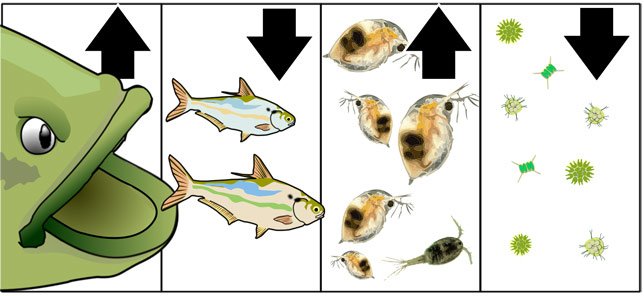Bears, Salmon, and Water Quality
Keystone Interactions: How Bears Influence Water Quality
From the paper: Helfield, J.M., Naiman, R.J. Keystone Interactions: Salmon and Bear in Riparian Forests of Alaska. Ecosystems 9, 167–180 (2006). https://doi.org/10.1007/s10021-004-0063-5
Keystone Species
Some species of plants and animals that have a much greater effect on their environment and the community of organisms around them than their numbers would suggest. These species are called "keystone" species and removing them from their community can have profound implications. In some cases, two keystone species interact with one another and the result is even more profound. One such example of "keystone interactions" is the story of sockeye salmon and brown bears in the Alaska.
The Role of Salmon
Salmon have an interesting life. They start out as fry in clear, typically nutrient-poor streams and eventually make their way to the ocean where they feed and grow. When the time comes for them to reproduce, they return to their hatching stream to spawn and then they die. The implications for their nutrient-poor streams are huge. Over millennia, nutrients have been washing downstream from higher elevations to eventually reach the sea. The salmon go to the ocean, collect nutrients by feeding, and eventually return those nutrients (as body weight) to the streams. The returned nutrients provide food for numerous animals and plants in the stream, which in turn provide food for the salmon fry the following year. Even non-aquatic organisms benefit from the nutrients salmon bring upstream. For example, researchers studying naturally-occurring stable isotopes found that riparian (near the water) plants near spawning streams acquire up to 26% of the nitrogen in their foliage from salmon.
A: Returning salmon bring marine nutrients to streams.
B: Bears kill salmon and (C) deposit carcasses near streambank.
D: Decomposition of carcass distributes marine nutrients in riparian zone.
E: Marine nutrients moves through hyporheic zone to vegetation.
F: Foliage is enhanced by marine nutrients.
G: Riparian trees improve habitat.
H: Woody debris retains carcasses and provides habitat for fry.
I: Enhanced riparian foliage alters species composition.
From Helfield et. al.
The Role of Bears
Bears in one Pacific Northwest stream were found to kill, on average, approximately 37% of spawning sockeye salmon. Salmon carried out of the water to the forest floor near the stream are partially eaten and the carcass is left to rot. If salmon are abundant or easy to catch, the bears will eat a smaller proportion of the fish and leave more to rot than if fish are scarce or hard to catch. The salmon carcasses are carried away and broken down by scavengers and decomposers, further distributing the nutrients.
Bears also distribute nutrients through waste excretion. Each adult female bear was shown to deliver about two-thirds of an ounce of nitrogen obtained from salmon per acre, primarily as urine. The scientist who collected that data must certainly have some interesting stories to tell. Urine is quickly converted to ammonium and becomes an available nutrient source for plants.
Nutrient Movement
Nitrogen from salmon is distributed nearly one-third of a mile on each side of the spawning streams, with the carcasses primarily near the stream and bear waste more prevalent at the far end of that range. Nitrogen from salmon can even move through the ground in the hyporheic zone, or the area under the stream bed where ground water and surface water interact.
Habitat Modification
Vegetation near spawning streams has elevated nitrogen content and is thus more desirable to animals such as moose and snowshoe hares. Riparian trees grow faster and denser when nutrient concentrations are higher and in the process stabilize the banks, filter sediment, shade the water and deposit debris. All these effects benefit the salmon fry which will eventually return as adults to contribute more nutrients to the stream system.
Computer models of the study stream showed that, through their interactions, salmon and bear together contributed significantly more to the flow of nitrogen in the riparian zone than either species could accomplish individually. The bear/salmon interactions benefit multiple organisms in the ecosystem, including vegetation, plant-eating animals, scavengers, decomposers, and other fish species. The loss of either species would have serious, adverse environmental consequences, affecting many plants and animals in the stream community.
In some aquatic communities largemouth bass are considered keystone species.
As the numbers of top-level predators (eg. Largemouth Bass) increase, the number of zooplankton grazing fish will decrease. This allows more large zooplankton to survive and consume algae.
Closer to home
The concept of keystone species can be applied, albeit less dramatically, to freshwater organisms in Missouri. For example, some predators are assigned keystone species status because of their ability to shape the food web and the environment around them. A previous Water Line article, "Top Down - Bottom Up," summarizes the trophic cascade and the ability of piscivorous fish to reduce the total amount of algae in lakes. Members of the zooplankton family Daphnia have been considered keystone species for their role in structuring the algal community through predation.


